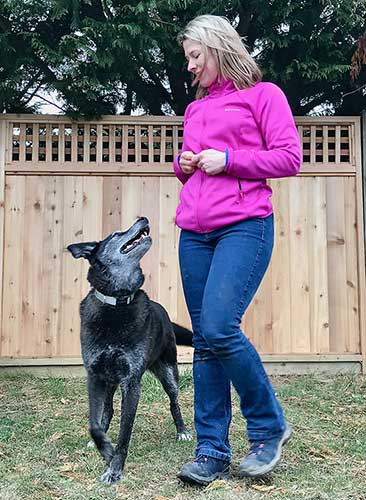Around six months of age, your adorable puppy starts growing up—and things can get a little wild. Welcome to adolescence! During this stage, your dog is becoming a canine teenager: full of energy, curiosity, and occasionally, defiance. While maturity is still a long way off, this is a critical window for training and relationship-building.
Even if your pup completed a basic obedience or puppy class, many pet parents find that training tends to take a backseat as life gets busier. Meanwhile, that once-small puppy is now adult-sized—making jumping, mouthing, pulling on leash, and other behaviors much harder to ignore.
This phase can be frustrating—but it’s also an incredible opportunity to reinforce good habits and strengthen your bond. At Mountainside Mutts, we offer flexible, supportive training options to help guide you and your dog through adolescence with confidence. Whether you prefer virtual coaching or in-person sessions, we’ll help you stay on track with training that fits your schedule and your dog’s needs.
Common adolescent behavior challenges include:
-
Not coming when called
-
Counter-surfing
-
Pulling on leash
-
Door darting
Ready to bring calm to the chaos? Book a consult today and let’s help your teenage dog grow into a well-mannered adult.
Around six months of age, your adorable puppy starts growing up—and things can get a little wild. Welcome to adolescence! During this stage, your dog is becoming a canine teenager: full of energy, curiosity, and occasionally, defiance. While maturity is still a long way off, this is a critical window for training and relationship-building.
Even if your pup completed a basic obedience or puppy class, many pet parents find that training tends to take a backseat as life gets busier. Meanwhile, that once-small puppy is now adult-sized—making jumping, mouthing, pulling on leash, and other behaviors much harder to ignore.
Common adolescent behavior challenges include:
-
Not coming when called
-
Counter-surfing
-
Pulling on leash
-
Excessive energy and restlessness
-
Jumping up
-
Mouthing or nipping
-
Door darting
This phase can be frustrating—but it’s also an incredible opportunity to reinforce good habits and strengthen your bond. At Mountainside Mutts, we offer flexible, supportive training options to help guide you and your dog through adolescence with confidence. Whether you prefer virtual coaching or in-person sessions, we’ll help you stay on track with training that fits your schedule and your dog’s needs.
Ready to bring calm to the chaos? Book a consult today and let’s help your teenage dog grow into a well-mannered adult.
Our teenage dog training and behavior change packages are designed for dogs between 6 months and 2 years of age. We will provide you with the knowledge and skills to set your dog up for success. But please don’t expect the use of aversive tools like prong, shock, or choke collars. We guarantee our training is L.I.M.A* compliant.
Fundamentals
- Includes: 75 minute initial consultation and two 1 hour training sessions.
- This is the package for you if your dog is generally pretty good and you enjoy training but there are one or two behaviors that need work. The aim of this package is to provide you with the information you need to progress your dog’s training.
Mind Your Manners
- Includes: 75 minute initial consultation, three 1 hour sessions at our facility, 1 field trip.
- Does it seem like your puppy has forgotten everything he learned at that training class? This package is designed for people who have done some training but whose dog seems to forget everything the instant you leave the house.
Teenage Delinquent
- Includes: 75 minute initial consultation, four 1 hour sessions at our facility, 2 training field trips and a 2 Hounds Design Freedom Harness.
- Your puppy’s jumping is becoming a real issue, he’s still mouthy, doesn’t come when call, pulls on leash, and “stubborn” is his middle name. You’ve not previously done any formal training.
*L.I.M.A – Least Intrusive Minimally Aversive
LIMA is a position statement jointly adopted by the Association of Professional Dog Trainers (APDT) and the International Association of Animal Behavior Consultants (IAABC). It establishes an ethical standard for working with dogs, and states that methods should be effective while also minimizing side effects and aversive experiences for the animal. Although LIMA includes and is often associated with the Humane Hierarchy, it involves much more than just the Humane Hierarchy. LIMA also sets a competency standard and states that “trainers/behavior consultants [should] work to increase the use of positive reinforcement and lessen the use of punishment,” that protocols should be “maximally humane,” and that trainers and behavior consultants should achieve and maintain a level of education that allows them to change behavior both effectively and humanely by minimizing any stress or aversive experience to the animal.
What is the Humane Hierarchy?
The Humane Hierarchy is a set of humane and effective practices for working with dogs. It sets up a suggested approach for effectively creating behavior change while also minimizing stress and discomfort to the animal. The Humane Hierarchy is listed below, in order from first line of treatment to least desirable choice.
1. Wellness: Nutritional and physical
2. Antecedent arrangements
3. Positive reinforcement
4. Differential reinforcement of alternative behaviors
5. Extinction, negative reinforcement and negative punishment
6. Positive punishment
Each step in the Humane Hierarchy should only be considered when the previous steps have been implemented to the fullest extent possible, by an individual who has the expertise to implement those methods effectively.
As a Professional Premium Member of the APDT, we are committed to the LIMA approach.




